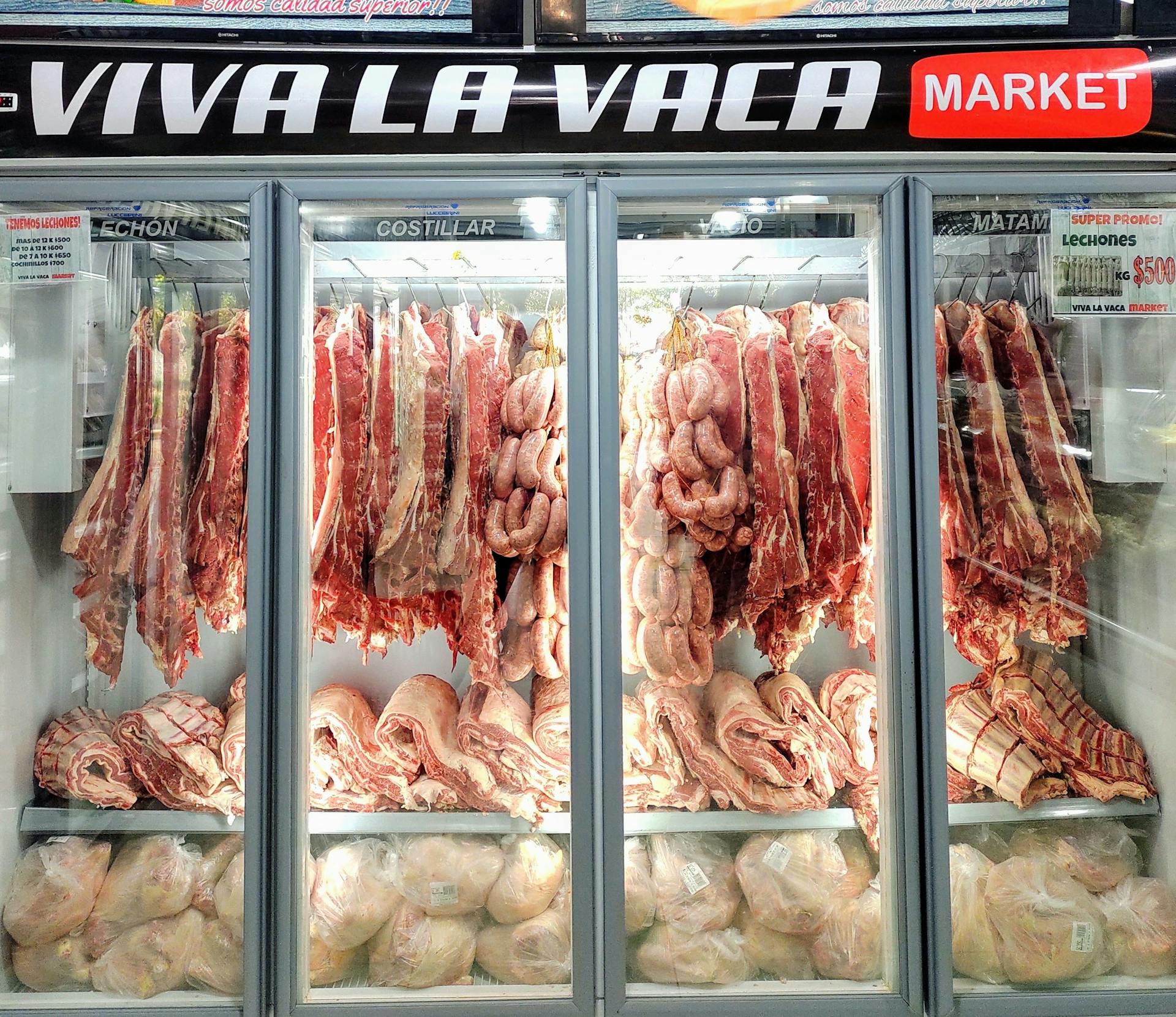
Raw meat diets for dogs have been a topic of debate for years, with some owners swearing by the benefits and others warning of the risks.
Feeding raw meat to dogs can be a more natural approach, as it mimics their ancestral diet.
However, it's essential to note that raw meat can pose a risk of bacterial contamination, such as Salmonella and E. coli.
Some proponents of raw meat diets claim that it can improve a dog's dental health and reduce the risk of allergies.
Benefits of Raw Meat for Dogs
Raw meat diets for dogs can have several benefits, including a healthier coat and skin. Researchers at the University of California, Davis found that dogs on a raw meat diet have a softer, shinier coat than those eating cereal-based dry food.
A raw meat diet can also improve a dog's breath and oral health. A study by Brown and Park found that dogs fed raw meat with bone fragments had more than 30% of their dental calculus removed within 24 hours.
Broaden your view: What Food Is Good for Dogs Skin and Coat
Some proponents of raw meat diets claim that they can help control conditions like diabetes, but further research is needed to confirm this. Always discuss diet with your veterinarian if your dog has an underlying disease.
A raw food diet can also improve digestion, with some believing that it enables dogs to absorb more nutrients. Raw food takes only one or two hours to digest, compared to kibble which stays in a dog's stomach for seven to nine hours.
Raw meat diets can also help maintain a dog's lean mass and healthy weight. According to some, a raw diet balances a dog's systems, helping them lose or gain weight as needed.
Dogs are designed to eat raw meat, with their digestive systems able to break it down quickly and efficiently. Their GI system is shorter than a human's, and they have stronger stomach acids to help digest raw foods.
For your interest: Golden Retreiver Weight
Potential Risks and Safety
Feeding your dog raw meat can be a bit of a gamble, and it's essential to understand the potential risks involved.
Raw meat can contain harmful bacteria like Salmonella and E. coli, which can make your dog and your family members sick. In fact, even if your dog doesn't get sick, they can still spread infective spores everywhere they go.
Some types of raw meat, like pork and wild game, can contain parasites or bacteria that can make your dog seriously ill. It's best to consult with a veterinarian before introducing any new type of raw meat into your dog's diet.
The risk of contamination is higher with raw meat than with cooked meat, as heat destroys many of the pathogens and germs present in raw meat. To reduce the risk of contamination, it's crucial to handle raw meat carefully and follow proper hygiene procedures.
Here's a list of bacteria and parasites found in raw meat that can harm your dog:
- Salmonella
- Listeria (L. monocytogenes)
- Campylobacter
- Clostridium (C. difficile and C. perfringens)
- E. coli
- Trichinosis (Trichinella spiralis)
By understanding the potential risks and taking the necessary precautions, you can minimize the dangers associated with feeding your dog raw meat.
Potential Risks
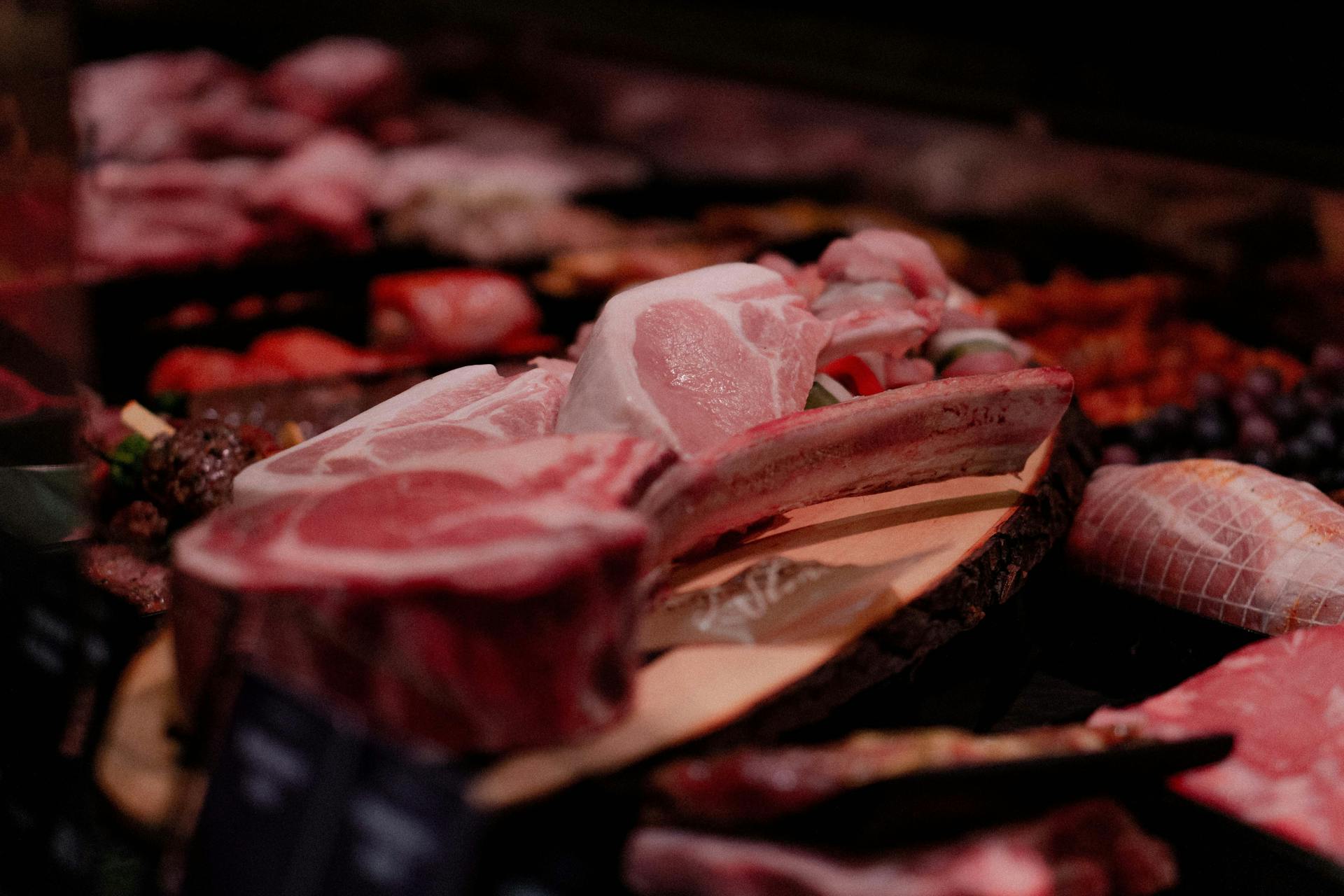
Feeding your dog raw meat can be a bit of a gamble, and it's essential to be aware of the potential risks. Most veterinarians advise against it, citing concerns about contamination and bacterial infections.
Raw meat can contain harmful bacteria like Salmonella or E. coli, which can make both dogs and humans sick. Handling raw meat requires careful attention to avoid cross-contamination.
To reduce the risk of contamination, it's crucial to handle raw meat properly. This includes washing your hands and any utensils or surfaces that come into contact with the meat.
Some common symptoms of food poisoning in dogs include vomiting, diarrhea, and lethargy. In severe cases, dogs may require veterinary treatment.
Here are some statistics on pet food recalls due to pathogenic bacteria contamination:
It's worth noting that dogs can eat raw meat without getting sick, thanks to their highly acidic stomach and natural digestive enzymes that help process even harmful bacteria. However, it's still essential to handle raw meat carefully and work with a veterinarian or trained nutritionist to ensure a balanced diet.
Food Hosts
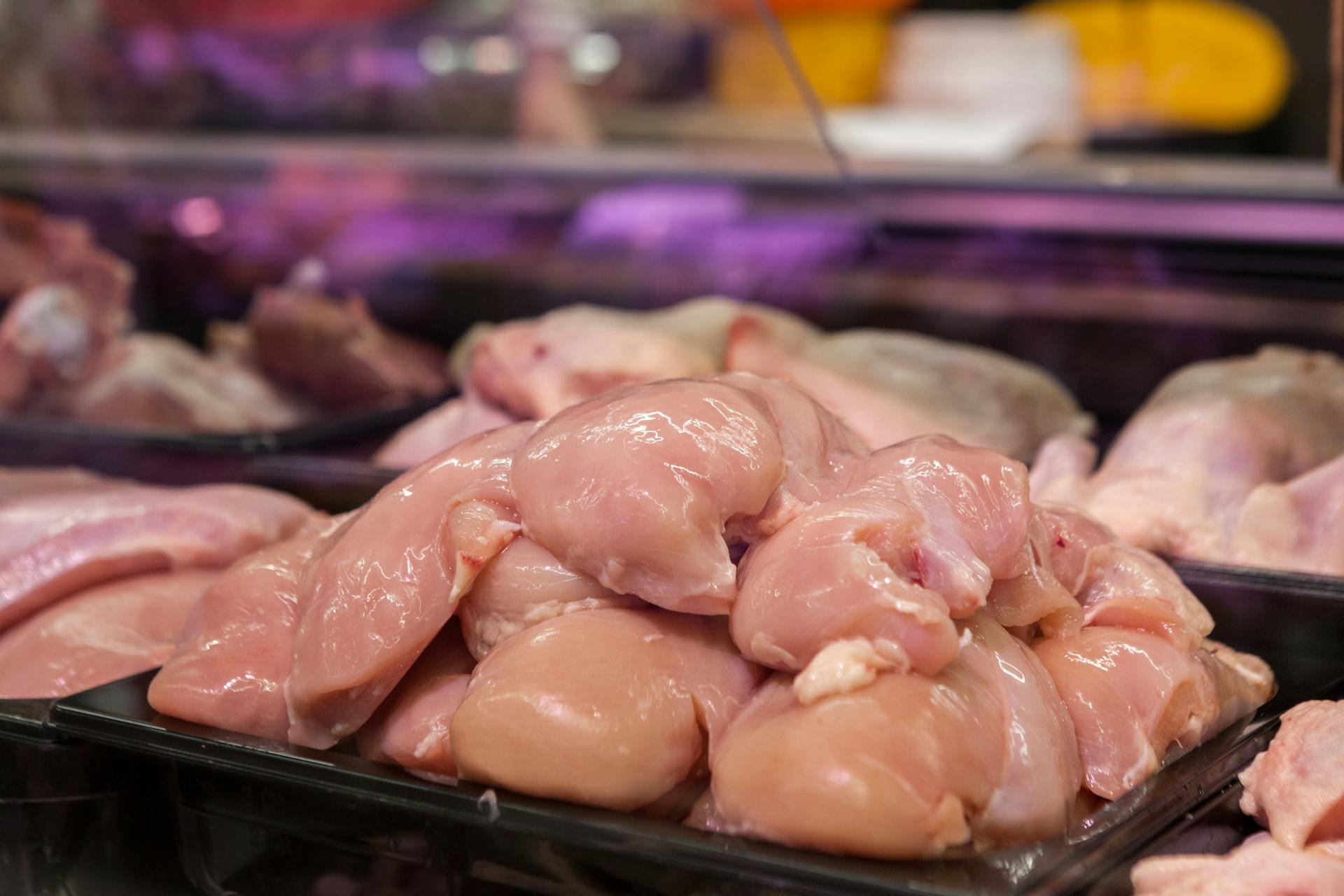
Raw dog food can host a variety of bacteria that can make your pet and your family sick. Raw meat presents a substantially larger risk of contamination than cooked meat because heat destroys many of the pathogens and germs present in raw meat.
Some of the pathogens that can be found in raw meat include Listeria, which can cause fever, breathing problems, muscle pain, and even death in rare cases. Campylobacter can cause watery diarrhea, abdominal pain or cramping, fever, and lethargy in dogs.
Clostridium can cause severe diarrhea in dogs, and there are two specific types of clostridium in dogs, Clostridium difficile and Clostridium perfringens. E. coli is usually benign in dogs, but symptoms can appear when the bacteria concentration is too high.
Trichinosis is a parasitic disease caused by a roundworm parasite called Trichinella spiralis, also known as “pork worm”. This infection usually results from eating contaminated raw or undercooked pork.
For your interest: Can Chihuahuas Eat Pork
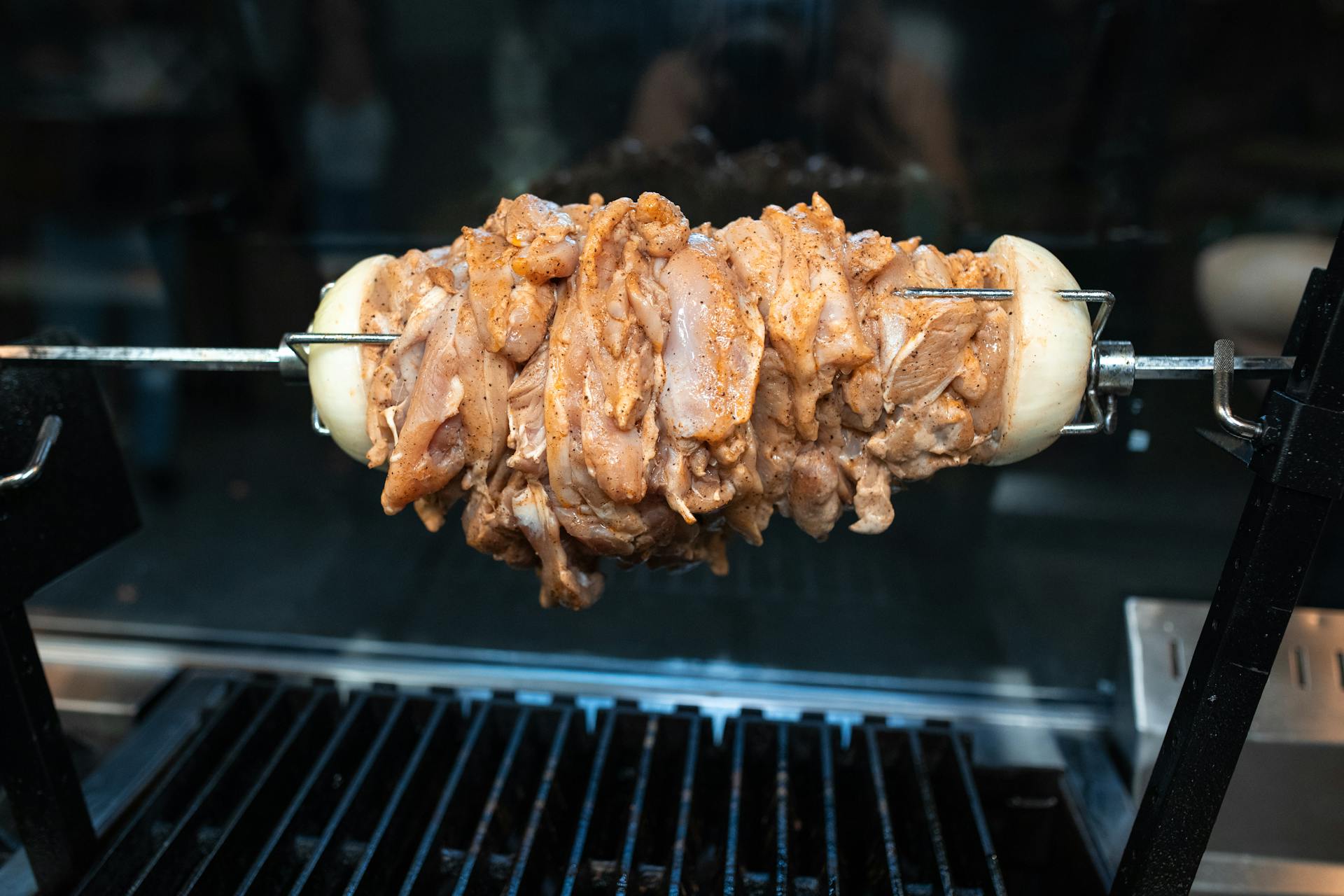
Here are some of the bacteria and parasites that can be found in raw dog food, along with their typical symptoms:
- Listeria: fever, breathing problems, muscle pain, and even death
- Campylobacter: watery diarrhea, abdominal pain or cramping, fever, and lethargy
- Clostridium: severe diarrhea
- E. coli: symptoms can appear when the bacteria concentration is too high
- Trichinella spiralis: infection usually results from eating contaminated raw or undercooked pork
Diets Aren't Well-Regulated
Raw meat diets aren't well-regulated, which can be a concern for pet owners. The American Veterinary Medical Association notes that raw pet foods are produced with little to no regulatory oversight by the state or federal governments.
Excessive vitamin A and D, as well as low levels of calcium and phosphorus, have been found in raw diets. This can lead to health problems if your dog is on a raw diet for an extended period of time.
It's essential to work with a veterinarian or trained nutritionist to ensure your dog gets a balanced diet. They can help you make informed decisions about adding raw meat to your dog's diet.
Studies have shown that unbalanced diets can damage your dog's health. This is especially true if you're considering a raw diet for your furry friend.
For more insights, see: Certificate of Good Health Dog
Safety Measures
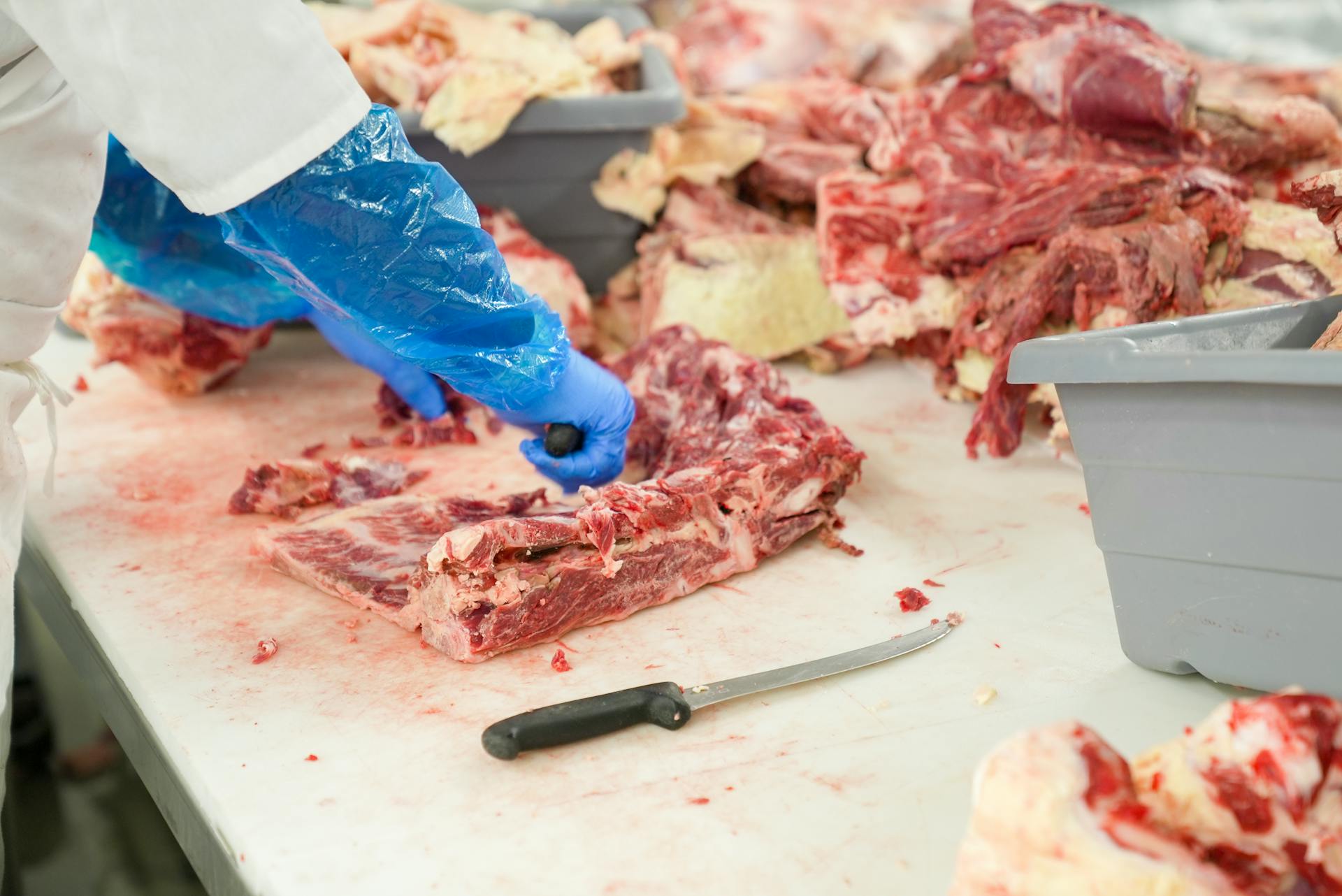
To minimize the risks associated with feeding raw meat to your dog, it's essential to take certain safety measures. Always choose high-quality meats that are stored and prepared correctly to avoid bacteria growth.
Handling raw meat requires careful attention to hygiene. Washing your hands or any other utensils and surfaces that come into contact with the meat is crucial to prevent cross-contamination.
Freezing raw meat until ready for use is another effective way to reduce the risk of bacterial contamination. This step can help ensure your dog's safety.
To further minimize the risk of contamination, keep raw meat separate from other foods, especially those that won't be cooked. This is a simple yet effective way to prevent cross-contamination.
High-Pressure Processing (HPP) is a non-thermal pasteurization technology that employs ultra-high water pressure to neutralize food-borne pathogens. This process can help eliminate bacteria like Listeria, E. coli, and Salmonella.
To ensure your dog gets a balanced diet, working with a veterinarian or trained nutritionist is a good idea. They can help you create a diet that includes raw meat in a safe and healthy way.
Explore further: Is High Protein Dog Food Good for Dogs
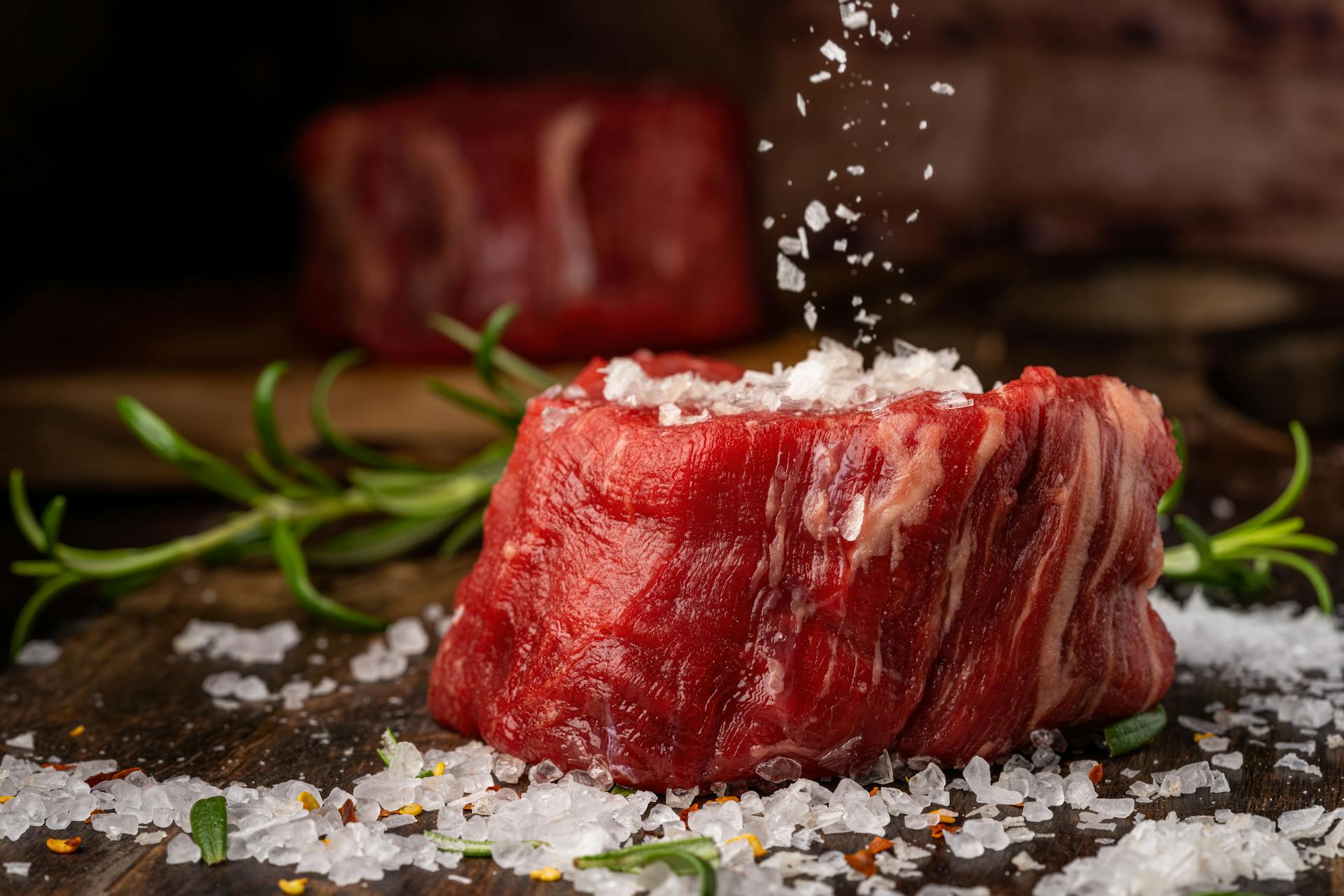
Here are some key tips to keep in mind when handling raw meat:
- Wash your hands before and after handling the meat
- Keep raw meat separate from cooked food
- Clean preparation surfaces and food bowls with soap and hot water
- Thaw meat in the refrigerator or microwave, not on the countertop
- Feed your dog the meat promptly, within a few hours of thawing
By following these safety measures and taking the right precautions, you can minimize the risks associated with feeding raw meat to your dog.
Reducing Pet Feeding Risks
Feeding your dog raw meat can be safe, but taking precautions is important to avoid contamination. Raw meat can contain harmful bacteria like Salmonella or E. coli, making dogs and humans sick.
To reduce the risk of contamination, it's essential to handle raw meat carefully. Washing your hands or any other utensils and surfaces that come into contact with the meat is a must. Keep raw meat separate from other foods, especially foods that won't be cooked.
Thawing meat in the refrigerator or microwave, not on the countertop, is also crucial. Feed your dog the meat promptly, within a few hours of thawing. Working with a veterinarian or trained nutritionist is also a good idea to ensure your dog gets a balanced diet.
Quality is an important factor when it comes to reducing the risks of raw dog food. Buy meats that look and smell fresh, and avoid giving your dog meat that has been lying out on the counter for too long. Freezing the raw meat until ready for use, keeping the raw meat separate from cooked food, and washing your hands before and after handling the meat are also important steps.
Here are some specific types of raw meat that can be safely fed to your dog when the proper precautions are taken:
- Beef
- Chicken
However, it's essential to avoid feeding your dog raw fish, as it can contain salmonella and parasites that can cause your dog to become very sick. Raw pork is also not safe for your dog, as it contains a bacteria called Trichinella spiralis that can cause digestive problems and muscle issues.
Dogs can eat raw meat and not get sick because of their digestive system that's designed to handle bacteria in the gut. Your dog has a highly acidic stomach and natural digestive enzymes that help them process even harmful bacteria without becoming ill.
Feeding Raw Meat to Dogs
Feeding raw meat to dogs can be a good idea, but it's essential to do it safely.
Raw chicken is a good source of protein for dogs and is generally safe to eat, but it's crucial to handle it carefully to avoid contamination with bacteria like Salmonella or Campylobacter.
Some dogs may have trouble digesting raw beef, so it's best to introduce it slowly and in small amounts.
Raw turkey can be a bit higher in fat than other meats, so it's essential to handle it carefully too.
Raw lamb can be a good choice for dogs with trouble digesting beef, but it's still important to introduce it slowly and in small amounts.
Not all types of raw meat are safe for dogs to eat, so it's best to consult with a veterinarian before introducing any new type of raw meat into your dog's diet.
Chicken, beef, and turkey are generally considered safe options for dogs, but it's still crucial to handle them carefully.
You might enjoy: What Is the Best Meat for Dogs
What Is Dieting
Dieting is a way of eating that's tailored to an individual's needs, but when it comes to dogs, some owners try to mimic their wild ancestors' diet.
A raw diet for dogs is a fad diet by which you only feed your pup raw meat and veggies based on what his wild ancestors would eat.
Some proponents of raw food diets claim it's more natural and has success stories, but much of this is anecdotal and lacks scientific backing.
These wild dogs wouldn't have had a particularly impressive life span, which raises questions about the benefits of a raw diet for modern dogs.
Featured Images: pexels.com


